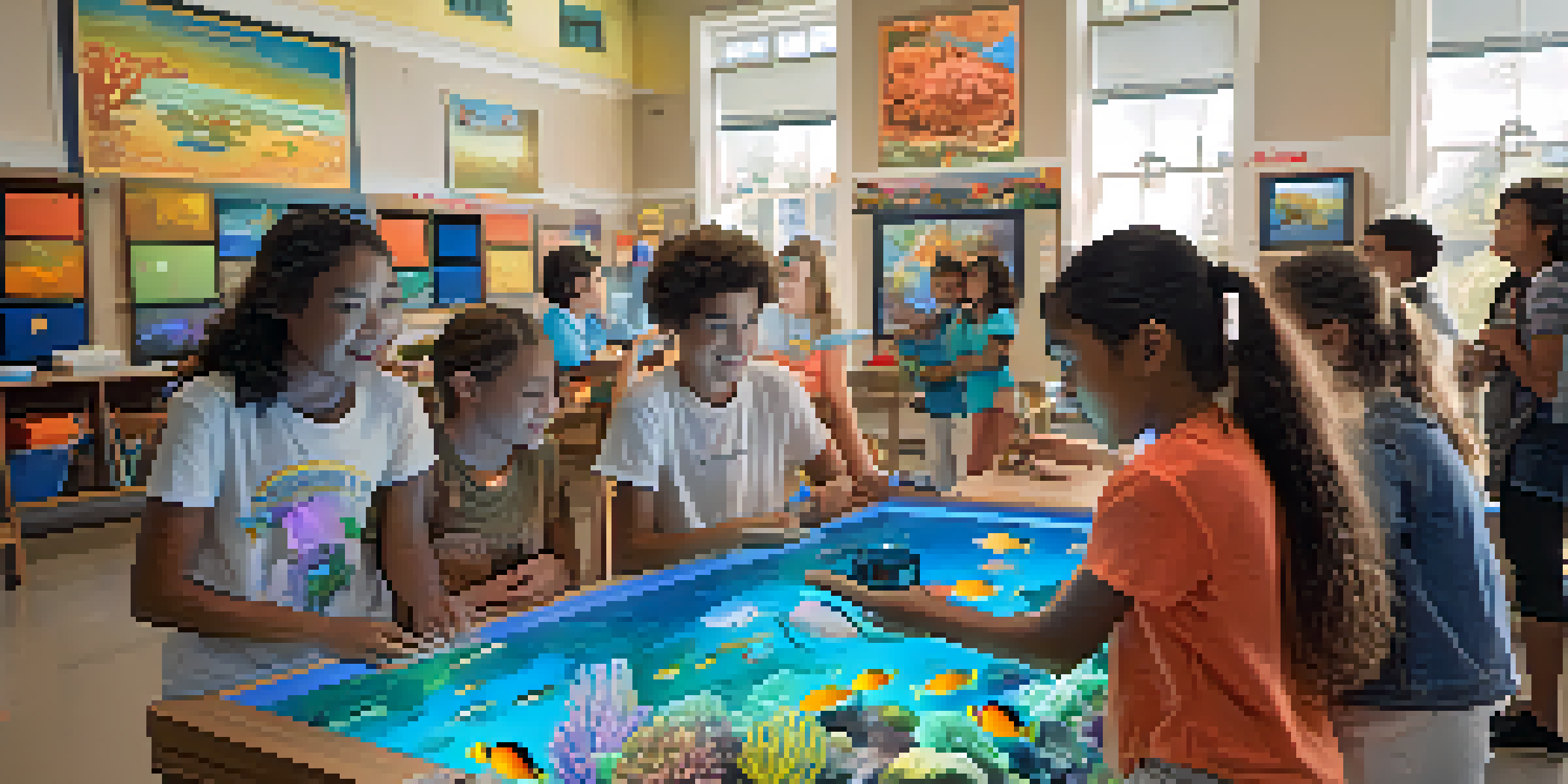The Role of AR in Environmental Awareness and Education

Understanding Augmented Reality and Its Potential
Augmented Reality (AR) blends digital elements with our real world, creating immersive experiences. Think of it as a layer of digital information that enhances what we see around us. This technology has progressed significantly, making it not just a tool for gaming but also for education, particularly in environmental awareness.
We do not inherit the earth from our ancestors, we borrow it from our children.
By utilizing AR, educators can illustrate complex ecological systems and environmental challenges in a more engaging way. For instance, imagine viewing a 3D model of a coral reef, complete with animated marine life, right in your classroom. This interactive approach helps students grasp the importance of biodiversity and the threats it faces.
Furthermore, AR can provide real-time data overlays, allowing learners to visualize pollution levels or climate impacts in their local environment. This shift from passive learning to active engagement is key in sparking interest and motivating action towards environmental stewardship.
Enhancing Environmental Education Through Immersive Experiences
AR transforms traditional environmental education by providing immersive experiences that capture attention. Instead of simply reading about climate change, students can visualize its effects through interactive simulations. For instance, they might see the melting of glaciers in real-time as they explore a virtual Earth.

These engaging experiences can evoke emotional responses, making the information more memorable. When learners see the direct impact of pollution on wildlife or forests, it fosters a deeper understanding and connection to the environment. This emotional link is crucial in motivating individuals to take action.
AR Enhances Environmental Learning
Augmented Reality transforms environmental education by providing immersive experiences that engage students and illustrate complex ecological concepts.
Moreover, AR can be implemented in various settings, from classrooms to outdoor learning environments. By integrating AR with field trips, students can interact with their surroundings in a dynamic way, enhancing their learning experience and promoting a greater appreciation for nature.
Case Studies: Successful AR Applications in Environmental Initiatives
Several organizations have harnessed AR to promote environmental awareness effectively. For example, the 'Wildlife AR' app allows users to see endangered species in their local environments, bringing attention to conservation efforts. This innovative approach not only educates users but also encourages them to support wildlife protection initiatives.
The greatest threat to our planet is the belief that someone else will save it.
Another notable case is the AR app created by the Ocean Agency, which immerses users in underwater ecosystems, showcasing the beauty of coral reefs and the devastating effects of coral bleaching. By experiencing these environments virtually, users are more likely to feel compelled to contribute to ocean conservation efforts.
These examples demonstrate that AR can bridge the gap between education and action. By making environmental issues relatable and visually engaging, these initiatives inspire individuals to become advocates for change.
Fostering Empathy and Connection to Nature Through AR
One of the most significant benefits of AR in environmental education is its ability to foster empathy. When users interact with virtual ecosystems and wildlife, they develop a personal connection to nature. This emotional bond can be a powerful motivator for individuals to advocate for environmental protection.
For instance, AR experiences that allow users to 'walk' through a forest or 'swim' with marine life can help them appreciate the complexity and beauty of these ecosystems. As they learn about the intricate relationships within these environments, they become more aware of their own impact on the planet.
Empathy Drives Conservation Action
Through interactive AR experiences, users develop a personal connection to nature, fostering empathy that motivates them to advocate for environmental protection.
Ultimately, this empathy translates into action, encouraging individuals to adopt more sustainable practices in their daily lives. By nurturing a sense of responsibility towards the environment, AR plays a crucial role in shaping the next generation of environmental advocates.
Challenges and Limitations of AR in Environmental Education
While AR offers exciting potential, it also comes with challenges and limitations. One significant hurdle is the accessibility of technology; not all students have access to AR-capable devices. This can create disparities in learning opportunities, particularly in underfunded schools or communities.
Additionally, developing high-quality AR content can be resource-intensive, requiring collaboration between educators, developers, and environmental experts. Ensuring that the information presented is accurate and engaging is crucial for effective learning.
Lastly, there is the challenge of maintaining student engagement over time. While AR can capture attention initially, educators must ensure that the content remains relevant and stimulating to sustain interest in environmental topics.
The Future of AR in Environmental Awareness and Education
As technology continues to advance, the future of AR in environmental awareness and education looks promising. Innovations in mobile devices and AR software will likely make these tools more accessible and user-friendly. This accessibility can lead to a broader integration of AR into educational curriculums across various age groups.
Moreover, partnerships between tech companies, educational institutions, and environmental organizations can foster the development of impactful AR experiences. Collaborating on projects that emphasize real-world environmental issues will enhance the relevance and urgency of the content presented.
Challenges of AR Accessibility
Despite its potential, AR faces challenges such as technology accessibility and the need for engaging, accurate content to maintain student interest.
Ultimately, the integration of AR into environmental education has the potential to inspire a global movement towards sustainability. By equipping individuals with knowledge and emotional connections to nature, we can foster a generation that is passionate about protecting our planet.
Conclusion: Embracing AR for a Greener Future
In conclusion, AR holds significant promise for enhancing environmental awareness and education. By transforming how we learn about our planet, it encourages deeper understanding and empathy towards ecological issues. As we embrace this technology, we pave the way for innovative learning experiences that resonate with learners of all ages.
The potential to engage and inspire individuals through immersive experiences is unparalleled. As we face pressing environmental challenges, the need for effective education becomes more critical than ever. By leveraging AR, we can empower individuals to make informed decisions and advocate for sustainable practices.

As we look to the future, it is essential to continue exploring how AR can be utilized in environmental education. Through collaboration, innovation, and a shared commitment to our planet, we can harness the power of technology to create a greener, more sustainable future.